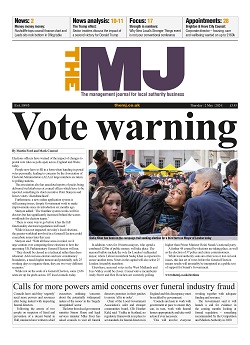One remarkable reaction to the brutal killing of George Floyd in the US has been the wave of UK-wide demonstrations that sprang up in localities which rarely - if ever - see political street protests. However, after this initial show of solidarity, there now seems to be a danger that this heartfelt instinct to fight racial injustice is becoming subsumed by divisive trends. Via the contentious rows over historic statues, councils are now at the heart of the UK’s new Culture War.
This recent bout of iconoclasm is posited as responding to a popular revulsion at honouring those with pro-slavery/colonialist views. But is this really responding to popular demand? It feels more complicated. Councils have been poring over an activists’ website Topple the Racists to create municipal audits of historic memorials statues, street, pub and buildings’ names, deemed unacceptable.
Mayor of London Sadiq Khan was quick off the mark to set up a Commission for Diversity in the Public Realm - an openly unelected, top-down body. Glasgow City Council even boasts it was discussing the issue ahead of any public debate: ‘We were already looking at this prior to the recent upsurge in interest…late last year, we became the first city in the UK to commission an in-depth academic study into our links to transatlantic slavery and colonialism.’
On the ground – and maybe it’s a lockdown thing - suddenly petitions and street protests are being treated as though a democratic mandate. When the Canal and River Trust removed the statue of slave owner Robert Milligan at West India Quay, it explained it was recognising ‘the wishes of the local community’. Really? In fact, it followed a petition launched by Tower Hamlets Labour councillor Ehtasham Haque demanding it was taken down.
Cheltenham Council responded to 25,000 people who had signed three separate change.org petitions calling for the removal of a statue of Robert Clive (AKA Clive of India). Did anyone check for duplications across the petitions? Were they all from the local area? These were not signatures collected door to door, but online, so can be signed anonymously, with no political persuasion or debate required.
LGA Labour claims its council leaders ‘will listen to and work with their local communities to review the appropriateness of local monuments and statues’. But listen to who? It would be disingenuous to pretend this is straightforward or uncontentious.
The whole debacle of the toppling of the Edward Colston statue in Bristol illustrates the point. The statue was still standing because after long-running disagreements, local politicians and the community were split (I wrote about it in The MJ years ago). Shadow foreign secretary Lisa Nandy told ITV’s Peston that the aggressive way the statue was pulled down was ‘the result of years of frustration and inaction with the democratic process’. So, if activists can’t get what they want, should vigilantism usurp democracy?
The reality is: statue removal cannot be assumed as the default anti-racist, popular position. There are legitimate tensions over dismantling cultural heritage. It doesn’t help to lazily label everyone who is opposed as far-right or apologists for slavery. No doubt bigots opportunistically use such issues to stir divisions. But to dismiss anyone who wants to defend Churchill or the local Cenotaph as a Tommy Robinson wannabe, slurs millions of citizens.
A racialised ‘identity politics’ narrative is equally problematic. For example, in Wales, Cardiff Cllr Huw Thomas has backed a petition to take down a sculpture of Carmarthen slave owner Sir Thomas Picton ‘because his presence is an affront to black people in the city’. But can councillors really claim to know what all black people think? In an essay in The Spectator, anti-imperialist writer Tanjil Rashid points out: ‘If the real mass of black and Asian people in this country were consulted, as opposed to an unrepresentative…set of activist-journalists who make this cause credible, it would be obvious these mute, lifeless effigies are not experienced as a ‘micro-aggression’, a notion that sounds frivolous to anyone who experienced the racial animus of earlier decades”. https://spectator.us/statue-topplers-white-men-history-raja-rammohan-roy/
And look who is getting the Colston treatment now? Should councils in Leicester and Manchester acquiesce to #GandhiMustFall activists demanding statues of Mahatma Gandhi (only erected in 2009 and 2019 respectively), be removed because thousands have signed online petitions calling the Indian independence icon a “fascist, racist and sexual predator”?
No disrespect, but councillors across the political spectrum are not historians: can they really – even if armed with petitions - arbitrate between messy, complicated historical disputes? In Manchester, a statue of the English Civil War figure Oliver Cromwell has been spray-painted with the words ‘Cromwell is a cockroach’ and ‘f*** racist’. As I’m second generation Irish, should I cheer that the brutal deaths of my ancestors are avenged? Or as a democrat, should I defend a key figure in creating a democratic parliament, having toppled a real king? Who decides?
As many councils now declare they face bankruptcy, I fear statue-toppling could be little more than inexpensive, anti-racist box-ticking. Achieving meaningful social justice is more difficult politically and financially. Dismantling public squares feels a distraction from the urgency of reinvigorating town and city centres in the wake of the potential economic devastation wrought by Lockdown. Black lives matter, but will black lives today be improved if local government becomes preoccupied by a war against inanimate objects and historical wrongs?
Claire Fox is director of the Academy of Ideas and a former MEP




